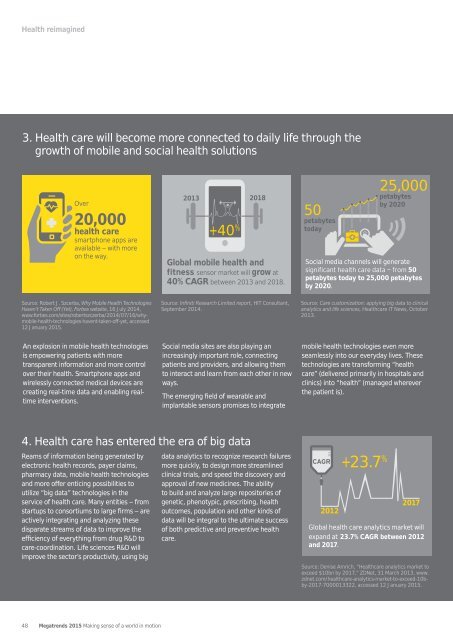ey-megatrends-report-2015
ey-megatrends-report-2015
ey-megatrends-report-2015
Create successful ePaper yourself
Turn your PDF publications into a flip-book with our unique Google optimized e-Paper software.
Health reimagined<br />
3. Health care will become more connected to daily life through the<br />
growth of mobile and social health solutions<br />
Over<br />
20,000<br />
health care<br />
smartphone apps are<br />
available — with more<br />
on the way.<br />
2013 2018<br />
+40 % Social media channels will generate<br />
Global mobile health and<br />
sensor market will grow at<br />
40% CAGR between 2013 and 2018.<br />
50<br />
petabytes<br />
today<br />
25,000<br />
petabytes<br />
by 2020<br />
50<br />
petabytes today to 25,000 petabytes<br />
by 2020.<br />
Source: Robert J. Szcerba, Why Mobile Health Technologies<br />
Haven’t Taken Off (Yet), Forbes website, 16 July 2014,<br />
www.forbes.com/sites/robertszczerba/2014/07/16/whymobile-health-technologies-havent-taken-off-yet,<br />
accessed<br />
12 January <strong>2015</strong>.<br />
Source: Infiniti Research Limited <strong>report</strong>, HIT Consultant,<br />
September 2014.<br />
Source: Care customization: applying big data to clinical<br />
analytics and life sciences, Healthcare IT News, October<br />
2013.<br />
An explosion in mobile health technologies<br />
is empowering patients with more<br />
transparent information and more control<br />
over their health. Smartphone apps and<br />
wirelessly connected medical devices are<br />
creating real-time data and enabling realtime<br />
interventions.<br />
Social media sites are also playing an<br />
increasingly important role, connecting<br />
patients and providers, and allowing them<br />
to interact and learn from each other in new<br />
ways.<br />
The emerging field of wearable and<br />
implantable sensors promises to integrate<br />
mobile health technologies even more<br />
seamlessly into our everyday lives. These<br />
technologies are transforming “health<br />
care” (delivered primarily in hospitals and<br />
clinics) into “health” (managed wherever<br />
the patient is).<br />
4. Health care has entered the era of big data<br />
Reams of information being generated by<br />
electronic health records, payer claims,<br />
pharmacy data, mobile health technologies<br />
and more offer enticing possibilities to<br />
utilize “big data” technologies in the<br />
service of health care. Many entities — from<br />
startups to consortiums to large firms — are<br />
actively integrating and analyzing these<br />
disparate streams of data to improve the<br />
efficiency of everything from drug R&D to<br />
care-coordination. Life sciences R&D will<br />
improve the sector’s productivity, using big<br />
data analytics to recognize research failures<br />
more quickly, to design more streamlined<br />
clinical trials, and speed the discovery and<br />
approval of new medicines. The ability<br />
to build and analyze large repositories of<br />
genetic, phenotypic, prescribing, health<br />
outcomes, population and other kinds of<br />
data will be integral to the ultimate success<br />
of both predictive and preventive health<br />
care.<br />
2012<br />
+23.7 %<br />
2017<br />
Global health care analytics market will<br />
expand at 23.7% CAGR between 2012<br />
and 2017.<br />
Source: Denise Amrich, “Healthcare analytics market to<br />
exceed $10bn by 2017,” ZDNet, 31 March 2013, www.<br />
zdnet.com/healthcare-analytics-market-to-exceed-10bby-2017-7000013322,<br />
accessed 12 January <strong>2015</strong>.<br />
48 Megatrends <strong>2015</strong> Making sense of a world in motion


